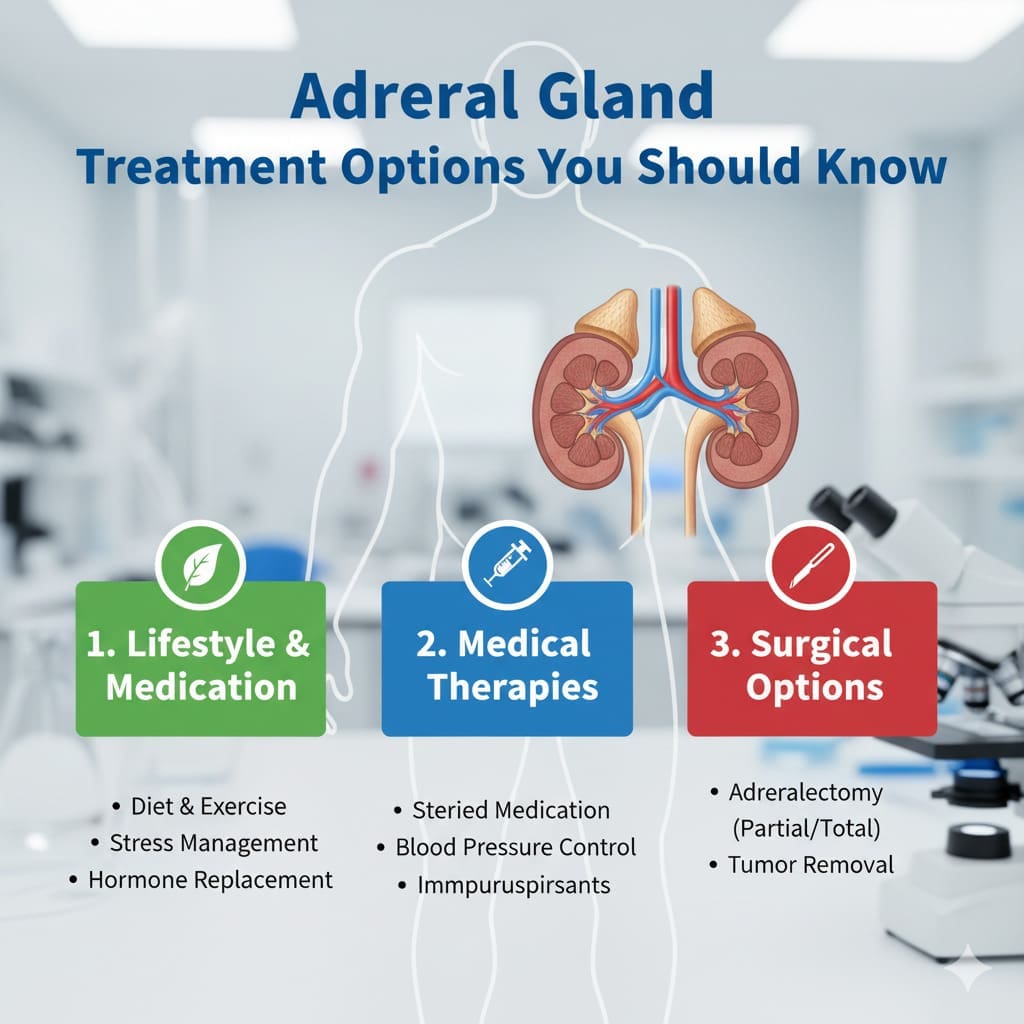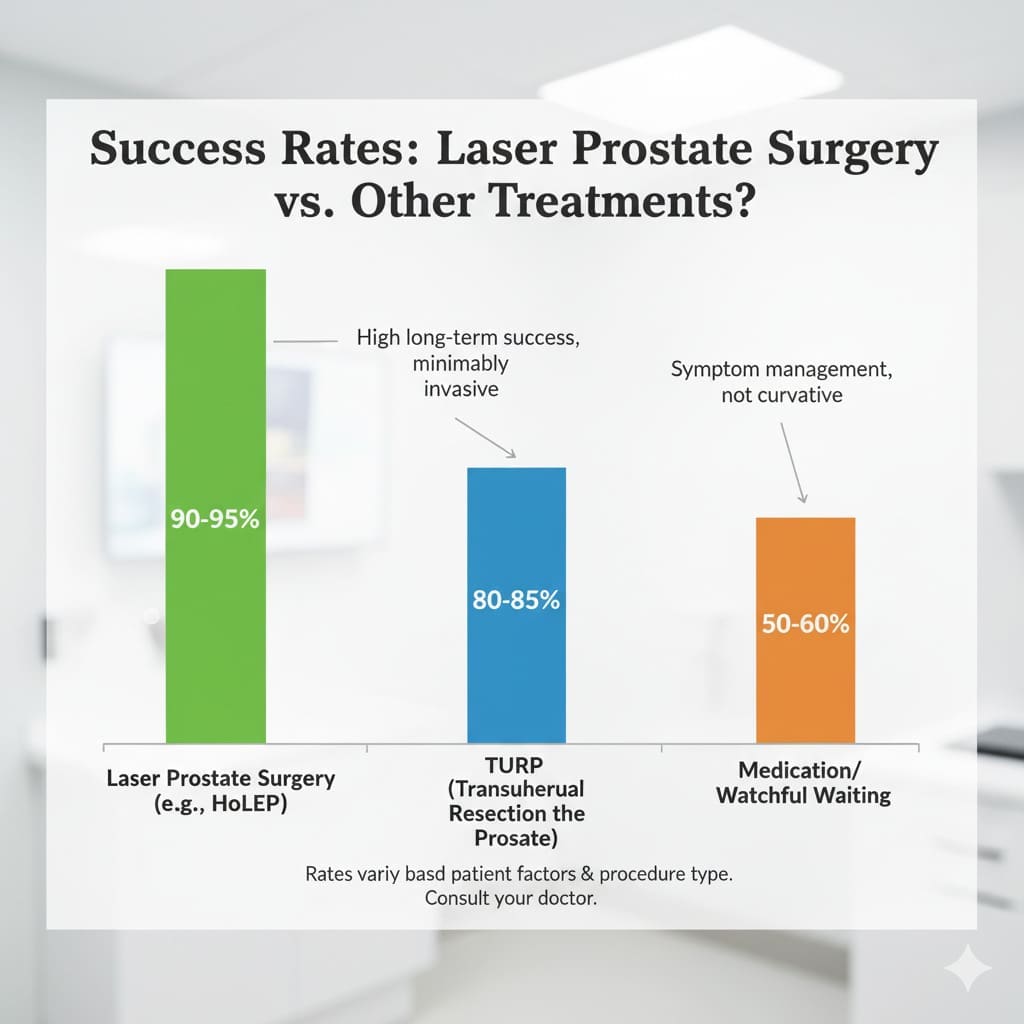Last Updated on November 26, 2025 by Bilal Hasdemir

Adrenal gland tumors are a big challenge in medicine. They need a special treatment plan. This plan should help with symptoms and think about long-term health.
At Liv Hospital, we get how hard it is to deal with these tumors. We offer detailed treatment plans. These plans are made just for you.
Our team works together to find the best ways to manage these tumors. We use surgery, radiation, and immunotherapy. This way, we aim for the best results for our patients.
Key Takeaways
- Personalized care for functional adenomas and hormone-producing tumors
- Comprehensive treatment plans tailored to individual needs
- Advanced treatment options, including surgery and immunotherapy
- Expert collaboration for effective management strategies
- Focus on balancing symptom relief with long-term outcomes
Understanding Adrenal Gland Tumors
The adrenal glands sit on top of each kidney. They can grow tumors that might make too much hormone. These glands help control blood pressure, metabolism, and how we handle stress.
What Are Adrenal Glands and Their Function
Adrenal glands are small, triangular glands in the endocrine system. They make hormones like adrenaline, cortisol, and aldosterone. These hormones help keep our body balanced and handle stress.
Types of Adrenal Gland Tumors
Adrenal gland tumors can be either benign or malignant. The main types are:
- Adenomas: Benign tumors that might make too much hormone.
- Pheochromocytomas: Tumors that make too much adrenaline, causing high blood pressure.
- Aldosteronomas: Tumors that make too much aldosterone, leading to high blood pressure and imbalances in electrolytes.
- Adrenocortical carcinomas: Malignant tumors that can make too much hormone or damage nearby tissues.
Functional vs. Non-Functional Tumors
Adrenal gland tumors are either functional or non-functional. Functional tumors make too much hormone and can cause symptoms. Non-functional tumors might not cause symptoms until they grow big enough to press on nearby tissues.
Knowing the type and function of adrenal gland tumors is key to finding the right treatment. We’ll look at treatment options in the next sections.
Diagnosing Adrenal Gland Tumors
Diagnosing adrenal gland tumors is key for good treatment. It involves checking symptoms, doing tests, and understanding the diagnosis. This process can be complex and worrying for patients.
Common Symptoms and Warning Signs
Adrenal gland tumors can cause different symptoms. Functional tumors make too much hormone, leading to specific signs. For example, Cushing’s syndrome, with weight gain and mood changes, can come from an adrenal tumor.
Other symptoms include palpitations, headaches, and sweating. These happen if the tumor makes catecholamines like adrenaline.
It’s vital to spot these symptoms early. Early diagnosis can greatly improve treatment. If you notice unusual or ongoing symptoms, see a healthcare professional right away.
Diagnostic Tests and Procedures
Diagnosing adrenal gland tumors requires several tests. First, imaging studies like CT scans or MRI are used. They help see the adrenal glands and find any issues.
Next, laboratory tests are key. Blood and urine tests check hormone levels. High levels of cortisol or aldosterone can show certain tumors.
Understanding Your Diagnosis
After tests, understanding your diagnosis is important. We explain the diagnosis, the tumor type (benign or malignant), and its health implications to patients.
Talking about treatment options for adrenal gland tumor is also part of this. Treatment can be surgery or other methods. We discuss each patient’s situation to help them make informed choices.
We combine medical knowledge with advanced tests to care for adrenal gland tumor patients. Our aim is to give patients the knowledge they need to decide on their treatment.
Comprehensive Tumor on Adrenal Gland Treatment Approaches
Dealing with adrenal gland tumors requires a variety of treatments. At Liv Hospital, we use a team of experts to create plans for each patient. This team includes doctors from different fields to meet each patient’s needs.
Individualized Treatment Planning
Every adrenal gland tumor removal plan is unique. It depends on the tumor and the patient’s health. Our team works with patients to make plans that fit their situation.
Multidisciplinary Team Approach
Our team has doctors from oncology, surgery, and more. Working together, we make sure patients get the best care. This approach covers all parts of a patient’s condition.
Factors Affecting Treatment Selection
Many things decide how to treat adrenal gland tumors. These include the tumor’s type and size, and the patient’s health. We think about these when making treatment plans.
| Factor | Description | Impact on Treatment |
|---|---|---|
| Tumor Type | The specific type of adrenal gland tumor | Influences the choice of treatment, such as surgery or medication |
| Tumor Size | The size of the adrenal gland tumor | Affects the decision for surgical intervention or other treatments |
| Patient’s Health | The patient’s overall health and presence of other medical conditions | Impacts the suitability of certain treatments and the patient’s ability to undergo surgery |
By looking at these factors and using a comprehensive tumor on adrenal gland treatment approach, we offer care that meets each patient’s needs.
Treatment Option 1: Adrenalectomy Surgery
Surgical removal of adrenal gland tumors, known as adrenalectomy, is a common and effective treatment approach. We specialize in providing care for patients undergoing adrenal tumor surgery. We aim for a smooth and successful recovery.
Open vs. Laparoscopic Adrenalectomy
There are two main surgical approaches for adrenalectomy: open and laparoscopic. Open adrenalectomy uses a larger incision to access the gland directly. It’s often used for larger tumors or cancer suspicions.
Laparoscopic adrenalectomy is a minimally invasive procedure. It uses small incisions for instruments and a camera. This method causes less tissue damage and leads to quicker recovery.
The choice between open and laparoscopic adrenalectomy depends on several factors. These include the tumor’s size and nature, the patient’s health, and the surgeon’s expertise.
Preparation for Adrenal Tumor Surgery
Preparation is key for a successful adrenalectomy. Pre-surgical evaluation includes a medical history review, physical exam, and diagnostic tests. Patients are advised to stop certain medications and manage any conditions that could impact the procedure.
We also educate patients on what to expect during recovery. This includes pain management and post-operative care instructions. We ensure they are well-prepared for surgery.
Recovery and Post-Surgical Care
Recovery from adrenalectomy surgery varies based on the approach and individual health. Patients may experience discomfort, managed with pain medication.
Post-surgical care includes monitoring for complications, managing pain, and gradually resuming activities. We provide detailed instructions on wound care, follow-up appointments, and when to resume normal activities. This ensures a smooth recovery process.
Treatment Option 2: Minimally Invasive Procedures
Minimally invasive treatments are changing how we treat adrenal gland tumors. They offer effective solutions with fewer side effects. These methods aim to reduce the need for big cuts, which helps in healing faster.
Radiofrequency Ablation
Radiofrequency ablation (RFA) uses electrical currents to create heat and kill tumor cells. It’s great for those who can’t have surgery because of health problems.
Benefits of RFA include:
- Less risk of complications than open surgery
- Shorter time to recover
- Can be done under local anesthesia
Cryoablation Techniques
Cryoablation freezes tumor cells to kill them. It’s a good option for those who can’t have traditional surgery.
Advantages of cryoablation:
- Uses small incisions
- Causes less damage to nearby tissues
- May have fewer side effects
Benefits and Limitations of Minimally Invasive Approaches
Minimally invasive procedures have many benefits but also some drawbacks. It’s important to consider these when choosing a treatment.
| Procedure | Benefits | Limitations |
|---|---|---|
| Radiofrequency Ablation | Minimally invasive, quick recovery | Not good for big tumors |
| Cryoablation | Less damage to nearby tissues | Risk of damage if not precise |
Choosing a minimally invasive procedure should be a careful decision. Talk to a healthcare provider to find the best treatment for you.
“The advancement in minimally invasive techniques has significantly improved the treatment landscape for adrenal gland tumors, providing patients more options and better outcomes.”
Treatment Option 3: Radiation Therapy for Adrenal Tumors
Radiation therapy is a precise and effective treatment for adrenal tumors. At Liv Hospital, we use advanced techniques to target tumors. This helps protect healthy tissues nearby.
External Beam Radiation
External beam radiation therapy (EBRT) is a common treatment for adrenal tumors. It uses high-energy beams from outside the body to hit the tumor. EBRT is great for tumors that can’t be removed or have come back after surgery.
Our team creates a treatment plan for each patient. This ensures the radiation dose is just right for the best results with few side effects. EBRT is given in several sessions to target the tumor well and protect other tissues.
This method helps control tumor growth and ease symptoms. It’s a key part of treating adrenal tumors.
Stereotactic Radiosurgery
Stereotactic radiosurgery (SRS) is another advanced radiation therapy. It focuses a high dose of radiation on the tumor with multiple beams. This is best for small, well-defined tumors. SRS is done in one session, making it easy for patients.
Our team at Liv Hospital is skilled in SRS. We use the latest technology for precise and effective treatment. This approach aims to get the best results with the least risk.
Managing Side Effects of Radiation
Radiation therapy can cause side effects like fatigue, nausea, and skin irritation. Our supportive care team works hard to manage these side effects. We help patients with nutrition, pain management, and more to improve their comfort and well-being.
For more information on our oncology services, including first-line treatments, visit Liv Hospital’s Oncology Page. Our team is dedicated to providing top-notch care and support every step of the way.
Treatment Option 4: Chemotherapy and Mitotane Therapy
Chemotherapy and mitotane therapy are key in treating adrenal gland tumors, like adrenocortical carcinoma. They offer big benefits to patients when used right.
Standard Chemotherapy Regimens
For adrenal gland tumors, we use standard chemotherapy to target fast-growing cancer cells. We mix different drugs to make it more effective.
The most common chemotherapy regimens include:
- Platinum-based chemotherapy: Uses drugs like cisplatin to stop DNA replication in cancer cells.
- Etoposide-based chemotherapy: Uses etoposide to stop cancer cells from growing by blocking topoisomerase II.
| Chemotherapy Regimen | Key Drugs | Mechanism of Action |
|---|---|---|
| Platinum-based | Cisplatin | Interferes with DNA replication |
| Etoposide-based | Etoposide | Inhibits topoisomerase II |
Mitotane for Adrenocortical Carcinoma
Mitotane is a special treatment for adrenocortical carcinoma. It damages the adrenal cortex, reducing hormone production and tumor growth.
We use mitotane in two main ways:
- Adjuvant therapy: After surgery to get rid of any leftover cancer cells.
- Palliative care: To control symptoms and slow tumor growth in advanced cases.
Monitoring and Managing Side Effects
Chemotherapy and mitotane therapy can cause big side effects. We watch patients closely to manage these effects well.
Common side effects include:
- Nausea and vomiting: Managed with antiemetic medications.
- Fatigue: Addressed through rest and nutritional support.
- Hormonal imbalances: Treated with hormone replacement therapy as needed.
By closely monitoring and managing these side effects, we can improve patients’ quality of life during chemotherapy and mitotane therapy.
Treatment Option 5: Targeted Therapy and Immunotherapy
Medical research is making big strides. Targeted therapy and immunotherapy are now promising treatments for adrenal gland tumors. These new methods give hope to those who didn’t respond to old treatments.
Emerging Targeted Treatments
Targeted therapy uses drugs that target cancer genes or proteins. For adrenal gland tumors, scientists are looking at therapies that block growth pathways. For example, drugs that stop the VEGF pathway are being tested to slow tumor growth by cutting off blood supply.
Targeted therapy might have fewer side effects than traditional chemotherapy. But, how well it works depends on the tumor’s specific traits.
Immunotherapy Approaches
Immunotherapy is another exciting area. It uses the immune system to fight cancer cells. Researchers are exploring different types, like checkpoint inhibitors, which help the immune system attack cancer more effectively.
Immunotherapy could offer targeted and less toxic treatments for adrenal gland tumors. Early results from clinical trials are promising.
Clinical Trials and Research Developments
The fields of targeted therapy and immunotherapy are growing fast. Many clinical trials are testing new treatments. These trials are key to finding out if new therapies are safe and work well.
As research keeps moving forward, more treatment options for adrenal gland tumors are emerging. Patients should talk to their doctors about these new therapies. This could help them find out if they qualify for any ongoing clinical trials.
Treatment Option 6: Hormone Therapy for Functional Tumors
Hormone therapy is a key treatment for functional adrenal tumors. It helps fix hormonal imbalances caused by these tumors. We’ll see how it manages these issues.
Managing Cushing’s Syndrome
Cushing’s syndrome happens when cortisol levels get too high, often from tumors. Hormone therapy for this condition uses medicines to control or counteract cortisol.
Medicines like ketoconazole or metyrapone lower cortisol levels. Sometimes, mifepristone is used to block cortisol receptors. This helps manage symptoms.
| Medication | Function | Common Side Effects |
|---|---|---|
| Ketoconazole | Reduces cortisol production | Liver toxicity, gastrointestinal issues |
| Metyrapone | Decreases cortisol synthesis | Hirsutism, hypertension |
| Mifepristone | Blocks cortisol receptors | Endometrial thickening, hypokalemia |
Treatments for Aldosteronoma
Aldosteronoma causes too much aldosterone, leading to high blood pressure and low potassium. Hormone therapy for this focuses on managing these symptoms.
Potassium-sparing diuretics like spironolactone or eplerenone are often used. They help control blood pressure and potassium levels.
Addressing Pheochromocytoma
Pheochromocytoma is a rare tumor that makes too much catecholamine. This causes high blood pressure, fast heart rate, and other symptoms. Hormone therapy for pheochromocytoma aims to control these symptoms before surgery.
Alpha-blockers like phenoxybenzamine manage blood pressure. Then, beta-blockers control heart rate. This helps patients before the tumor is removed surgically.
Understanding and using hormone therapy helps manage functional adrenal gland tumors. It improves patient outcomes.
Treatment Option 7: Watchful Waiting and Active Surveillance
Watchful waiting and active surveillance are key in managing adrenal gland tumors without immediate action. This method involves closely watching the tumor and the patient’s health. It allows for quick action if needed.
When Observation Is Appropriate
Watchful waiting is suitable for patients with small, non-functional adrenal tumors that don’t cause symptoms. Regular monitoring is key to ensure the tumor doesn’t grow or turn cancerous.
Recent studies suggest that for small adrenal tumors found by chance, a careful watch with regular scans is a good plan.
Monitoring Protocols
Good monitoring includes regular scans like CT or MRI and health checks. Following a monitoring plan is vital for catching any problems early.
- Regular imaging tests (e.g., CT scans, MRI)
- Clinical assessments for symptoms and hormonal imbalances
- Laboratory tests to monitor hormonal levels
When to Transition to Active Treatment
The choice to move from watchful waiting to active treatment depends on several factors. These include tumor growth, symptoms, or hormonal level changes. Timely intervention is key to avoid complications and improve results.
Doctors stress that careful watching and being ready to change the treatment plan is essential. This ensures patients get the best care for their situation.
Life After Adrenal Tumor Treatment
The journey doesn’t end with adrenal tumor treatment; it’s just the start of a new chapter. This chapter involves careful follow-up care. Patients must navigate the complexities of post-treatment care to ensure the best outcomes.
We know life after adrenal tumor treatment can be tough. But with the right support and guidance, patients can manage their condition well.
Hormonal Changes and Weight Loss
Managing hormonal changes is a big challenge after treatment. Tumors can disrupt hormone production, causing weight loss or gain. “Hormonal imbalances can be tough to manage,” says a leading endocrinologist. “But with the right treatment plan, patients can regain their health and well-being.”
We work closely with patients to monitor their hormone levels. We adjust their treatment plans as needed to mitigate these effects.
Follow-up Care and Monitoring
Follow-up care is key after adrenal tumor treatment. It helps monitor for any signs of recurrence or long-term effects. Regular check-ups allow for early detection and management of issues.
We recommend a follow-up schedule tailored to each patient’s needs. This may include imaging tests, blood work, and physical examinations. By staying vigilant, we can address any concerns promptly and ensure the best quality of life.
We also educate patients on the importance of self-monitoring. Recognizing signs that may indicate a need for medical attention is key. This collaborative approach empowers patients to take an active role in their recovery.
Conclusion: Making Informed Decisions About Adrenal Tumor Treatment
It’s important for patients to know about the different ways to treat adrenal gland tumors. We’ve looked at seven effective treatments, like surgery and radiation therapy. The right treatment depends on the tumor’s type, size, and the patient’s health.
Understanding your treatment options is key. Working with a team of specialists helps create a plan that fits your needs. This approach can improve your chances of a good outcome.
At Liv Hospital, we offer top-notch care and support. Our team is committed to helping patients get the best results. By staying informed and working with your healthcare team, you can manage your treatment well.
FAQ
What are the common symptoms of adrenal gland tumors?
Symptoms include high blood pressure and weight gain. Muscle weakness and hormonal imbalances are also common. Some people may feel anxious, have palpitations, or sweat a lot. The symptoms depend on the tumor’s type.
How are adrenal gland tumors diagnosed?
Doctors use CT scans, MRI, and PET scans for diagnosis. Hormonal tests also help. Sometimes, a biopsy is needed to know the tumor’s nature.
What are the treatment options for adrenal gland tumors?
Treatments include surgery, like adrenalectomy, and minimally invasive methods. Radiation, chemotherapy, and hormone therapy are also options. The right treatment depends on the tumor’s details.
What is adrenalectomy surgery, and when is it recommended?
Adrenalectomy surgery removes the adrenal gland with the tumor. It’s for both benign and malignant tumors. Laparoscopic adrenalectomy is a less invasive choice for some patients.
What are the benefits of minimally invasive procedures for adrenal gland tumors?
These procedures cause less pain and have shorter hospital stays. They help patients recover faster. They’re good for smaller tumors or those not suited for surgery.
How does radiation therapy work for adrenal gland tumors?
Radiation therapy kills tumor cells with high-energy beams. It’s used for malignant tumors or when surgery is not possible. Techniques include external beam radiation and stereotactic radiosurgery.
What is the role of chemotherapy in treating adrenal gland tumors?
Chemotherapy treats malignant tumors, like adrenocortical carcinoma. Mitotane is a drug used for this. Chemotherapy plans are made based on the tumor’s characteristics.
What is targeted therapy, and how is it used for adrenal gland tumors?
Targeted therapy uses drugs that target tumor cells’ molecular flaws. New treatments are being explored for adrenal gland tumors. They offer hope for advanced or resistant tumors.
How is hormone therapy used to manage functional adrenal gland tumors?
Hormone therapy manages hormonal imbalances from functional tumors. For example, it controls excess cortisol in Cushing’s syndrome. It also manages aldosterone in aldosteronoma and catecholamines in pheochromocytoma.
What is watchful waiting, and when is it appropriate for adrenal gland tumors?
Watchful waiting means monitoring without immediate treatment. It’s for small, non-functional, and benign tumors. Regular checks help decide when to start treatment.
What can patients expect during recovery from adrenal tumor treatment?
Recovery depends on the treatment. After surgery, managing hormonal changes and long-term effects is key. Follow-up care is important for any issues that arise.
Why is follow-up care important after adrenal tumor treatment?
Follow-up care monitors hormonal changes and detects recurrence early. It also manages long-term effects. Specialized centers like Liv Hospital provide tailored follow-up care.
References
American Cancer Society — Adrenal Cancer Treatment by Stage
https://www.cancer.org/cancer/types/adrenal-cancer/treating/by-stage.html
National Cancer Institute — Adrenocortical Treatment PDQ
https://www.cancer.gov/types/adrenocortical/patient/adrenocortical-treatment-pdq
UofMHealth — Adrenal Cancer Care & Treatment
https://www.uofmhealth.org/our-care/specialties-services/adrenal-cancer






